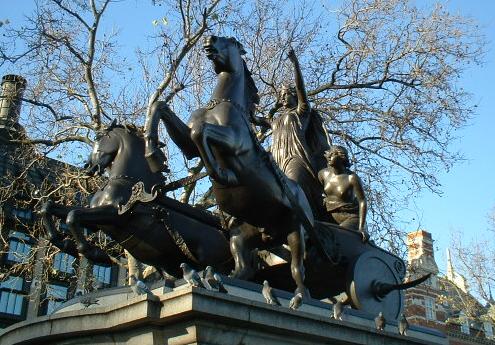Note: This is a cross-posting from Paul Holmquist’s “Neverwhat?” blog, chronicling his research for directing our spring MainStage production of Neverwhere. This post is by Maren Robinson, our production dramaturg.
Character Study: Hunter
I wanted to pause and explain the brief character studies that I am posting. When you read a book you take the characters as they are written. When an actor brings a character to life on stage there is additional material that may help the actor create a convincing portrayal of a character that is not on the page. If a character is a historical figure then there are biographical accounts to help a character construct a role but when the character is fictional it is more complicated.
In the case of the characters in Neverwhere, Paul and I have been discussing the fairy tale or mythological figures that inform the some of the characters as source materials for the actors.
Hunter: The name itself is shows the simplicity of early naming. In which person was defined by a job such as Miller, Smith, Wright would have referred to the miller the smith and the wheelwright or cartwright. (Hammmersmith, another character in Neverwhere is similarly named and as Hunter is a hunter he is indeed a metal smith).

In addition to the simplicity of her name Hunter feels ancient and her motivations seem very primal, taciturn and therefore mysterious. She has excellent mythological predecessors the Greek/Roman goddess Diana/Artemis, a virgin dedicated to the hunt. The Diana of Anet by Goujon is shown above.
The Amazons, known more as warriors than hunters but recognized for their fierceness in battle and apocryphally for cutting off one breast to make it easier to string their arrows. Penthesilea and Hippolyta are perhaps the best known of the Amazons the former having been involved in the Trojan War and the later appears in the labors of Hercules and later revived by Shakespeare as a character in A Midsummer Night’s Dream.

There is also an early Briton analog in the warrior queen Boudicca (sometimes written as Boadicea) who led a rebellion against Roman occupiers. The Anglo-Saxons had a belief in the fundamental danger of nature and an afterlife that consisted mostly in the praise and after-singing of the people who still lived and would sing of your great deeds. Pictured above is a statue by Thomas Thorncroft of the warrior queen which is, appropriately, in London. Which seems to fit with Hunter’s valuing most highly her deeds.
That she is hunting the beast of London also evokes various mythological references. In the Mabinogion (I know I keep referring to this it really is a fantastic source – sorry) Culhwch kills a boar as one of the tasks he must fulfill to win his bride Olwen. Hercules kills the Erymanthian Boar. A unique twist on on the boar in mythology is the Norse goddess Freya, who is sometime portrayed riding the boar, Hildisvini, into battle rather than attacking the creature. This is not to say the beast of London is necessarily meant to be a boar but to give just a few examples of the monsters that must be killed by a hero or the relationship of a beast to some sort of immortality. The beast leads me to the reluctant hero Richard Mayhew but I will save him for another day.
